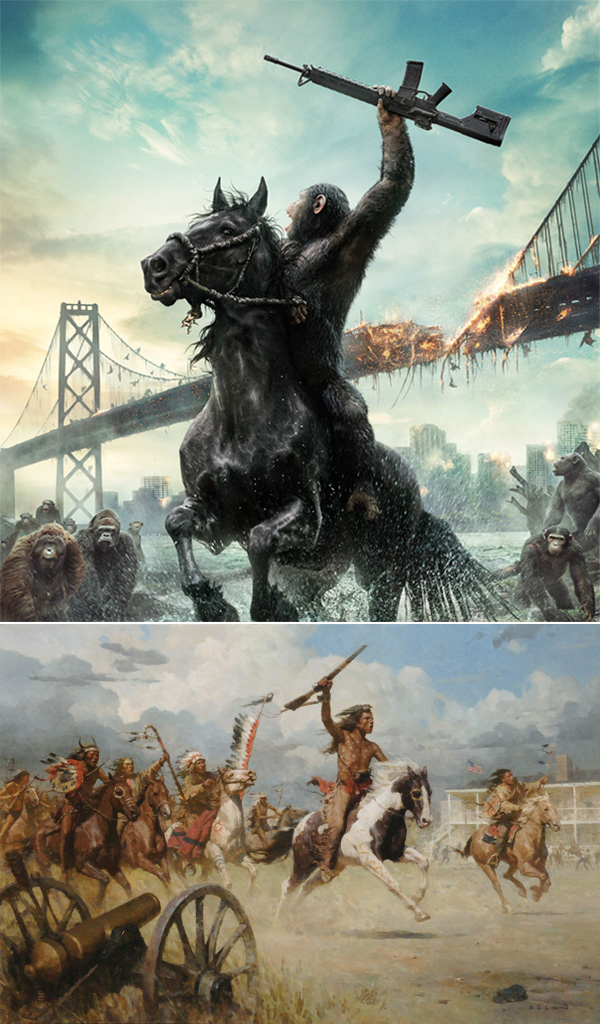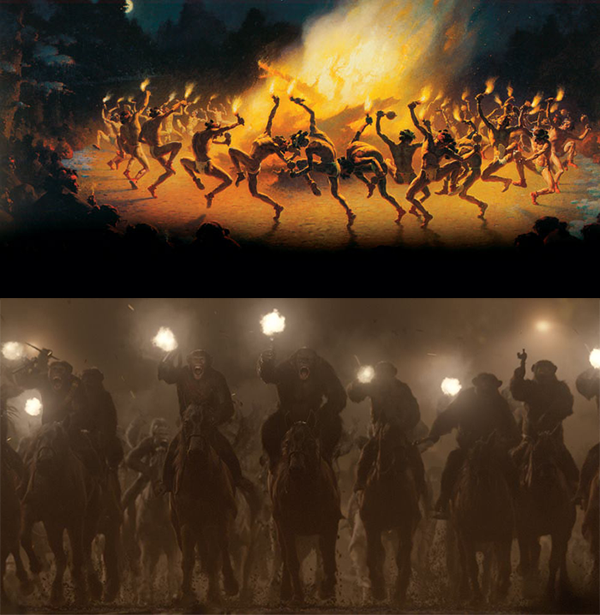
Many film critics, including some of the most astute, have written praises for the 2014 movie “Dawn of the Planet of the Apes”. I greatly enjoyed a few scenes and marveled at many shots that are visually stunning. I also found it an offensively lazy and shallow commercialization of its predecessors. This is why.
In the 1963 novel “The Planet of the Apes”, the society of humans has regressed such that men and women live like foragers while the society of apes has advanced such that it has stratified into “aggressive gorilla soldiers, pedantic and politically conservative orangutan administrators, and liberal chimpanzee intellectuals.”
Written by Pierre Boulle, who also wrote about a society in crisis in The Bridge Over the River Kwai, the original “Planet of the Apes” is a satire of ideological blindness and post-war European society. When Boulle’s novel was adapted into a movie by the gifted polemicist Rod Serling, it became a critique of progress: a stark reminder that human society does not always advance.
Both Boulle and Serling were veterans of World War II. Both suffered personally and witnessed the suffering of others. Their allegorical ape society consisted of a distinctly modern assortment of violent thugs, ineffectual bureaucrats and effete intellectuals.
The 2014 adaptation of their work, “Dawn of the Planet of the Apes”, depicts a society based on a pre-modern fantasy of Native Americans and other “primitive peoples” as fundamentally pure.
The Pernicious and Lasting Myth of Civilization as the Corruption of the Noble Savage
The term noble savage is a literary stock character that expresses the concept of an idealized indigene, outsider, or “other” who has not been “corrupted” by civilization, and therefore symbolizes humanity’s innate goodness.
In “Dawn”, the apes are noble savages living in harmony with nature, organized as a clan and uncurious about the outside world. When the White man arrives to their land, in search of the natural resources that are important to His way of life, the most noble savage, the ape Cesar, grants a concession to the outsiders.
However, one of his own clan, the ape Koba (apparently so named as a reference to Joseph Stalin), betrays Cesar and launches a war against the White man. Koba’s war allows the filmmakers to show the apes behaving savagely – not as animals but, rather, as primitives.
In the directly previous Apes movie, the apes climbed and swung from roof to roof. In this movie, even though the structure the apes are attacking has an open rooftop, the apes are shown only as runners and horseback riders. Moreover, they travel from frame right to left – a cinematic move that often signifies moving backwards.
The directors thus chose to invoke a legacy of visual art that depicts Native Americans, on horseback, using rifles to besiege a fort filled with largely unarmed families, mostly white.

When the ape Cesar ultimately kills Koba, he does so only after proclaiming that Koba is not an ape. The screenwriters are asserting that only a non-ape could wage war with such demonic glee. Cesar remains a noble savage.
Much of the movie’s running time is devoted to the run-up to a violent war, thus allowing no time for the resolution of conflict. That work, apparently, will be handled in a sequel. And so, audiences are presented with a story in which evolution leads to war because… it sells tickets.
This latest Apes movie, which cost $170mm to produce, is being lauded for its truly astounding visual effects. In this way, its reception is similar to the 2009 movie Avatar which also consisted of a conflict between an ecologically minded race of humanoids and their would-be colonizers: humans fleeing from a war-torn industrial society. In fact, the team behind this most recent Planet of the Apes movie is said to be writing a future installment of the Avatar series.
But the technical achievement adds insult to injury. The movie uses high-technology and an abundance of material wealth to peddle an ideology discredited hundreds of years ago and directly contradicted by its source material.
The original Planet of the Apes was a satire of modern society. It made no claims to the past. It regarded neither Ape nor Man as pure. It was as honest and truthful as art can be. This version is neither.
By re-staging how the West was won as a tale of innocence lost, the movie tries to imbue the apes with a purity that is pure fantasy. We are the apes in this allegory, always have been and always will be.
We make tools, including weapons. We are explorers and we are curious about the outside world – as well as the world inside our minds. There was no version of us that was otherwise. We have always been capable of both compromise and savagery. There is no one else in the room. There is no better version of us – it’s just us.
